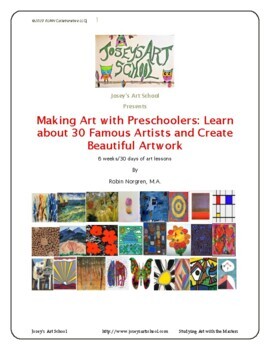30 Art Lessons Famous Artists Art History Pre-K -4th grade 6 week lessons
- PDF
Description
This art curriculum teaches about 30 famous artists and encourages students to create art inspired by them. This product is a wonderful way to engage your students in the creative process while also teaching them about important art movements and techniques.
Here are some ideas for incorporating an art curriculum that features 30 famous artists into your classroom:
- Introduce the artists: Start by introducing your students to each of the 30 famous artists in the curriculum. Provide them with information about each artist's life, style, and technique. You can use videos, books, or other resources to help illustrate their work.
- Explore art movements: As you introduce each artist, discuss the art movements they were a part of and the techniques they used. For example, you can discuss the Impressionist movement when studying Claude Monet, or the Pop Art movement when studying Andy Warhol.
- Create art inspired by the artists: After introducing each artist, have your students create their own artworks inspired by the artist's style and technique. Provide them with materials such as paint, pencils, markers, or clay to create their own unique pieces of art. Encourage them to experiment with different techniques and materials to create their own unique style.
- Display student artwork: Once your students have completed their art projects, display them in the classroom or school art gallery. This can be a great way to showcase your students' creativity and encourage them to continue exploring different artistic styles.
- Discuss the creative process: Use the art curriculum as a way to discuss the creative process with your students. Talk about how artists use different techniques and materials to create their work, and encourage your students to reflect on their own creative process as they create their own artworks.
By incorporating an art curriculum that features 30 famous artists into your classroom, you can help your students develop their creativity while also teaching them about important art movements and techniques. These lessons can serve as a springboard for discussions about history, culture, and self-expression.
THIS LESSON COMPLIES WITH MANY ELA COMMON CORE STANDARDS
Making Art with Preschoolers: Learn about 30 Famous Artists and Create Beautiful Artwork 6 weeks/30 days of art lessons
-FULL COLOR AND THOROUGH step by step instructions written by an AMI Montessori trained Primary/Preschool and Kindergarten teacher.
Thirty artists:
Table of Contents
Alma Thomas - Orange and Blue composition …………………………………………………7
Vincent Van Gogh -Sailboats ……………………………………………..15
Henri Rousseau - Snake line drawing …………………………………………………24
Wayne Thiebaud - Cupcakes ………………………………………………...32
Jean-Michel Basquiat - Cities …………………………………………..40
Jasper Johns - Target ……………………………………………………..50
Mark Rothko - No. 6 Violet Green and Red ………………………………………………………57
Piet Mondrian - Composition II ……………………………………………………66
Lipunja - Aborginal Art ……………………………………………………………..75
Georgia O’Keefe - Black Mesa Landscape …………………………………………………85
Andy Warhol - Red Flowers ……………………………………………………..94
James Rizzi - Cruising on a Love Boat ……………………………………………………..102
Terrell Powell - Owls …………………………………………………….113
Eric Carle - Tiny Seed ………………………………………………………….124
Paul Klee - Twilight ………………………………………………………….132
Jim Dine - Four Hearts ……………………………………………………………150
Pablo Picasso - Cubism inspired Dogs ……………………………………………………..159
Roy Lichtenstein - Sunrise ………………………………………………….171
Gustav Klimt - Birch Forest ……………………………………………………….180
Laurel Burch - Cats ………………………………………………………..189
David Gerstein - Butterflies ……………………………………………………..198
Alexander Calder - Fleur …………………………………………………..209
Andrew Brischler - Goodbye to All That ……..…………………………………………….216
Romero Britto - Bird ……………….……………………………………….223
Joan Miro - Portrait II ………………………………………………………………231
Claude Monet - Japanese Footbridge ………………………..………………………………240
Henri Matisse - Vase of Amaryllis …………………………………………………………253
Betye Saar - Eye ………………………………………………………………262
Faith Ringgold - Quilt Paper project …………………………………………………………272
Paul Cezanne - Basket of Apples ………………………………………………………….287
Each Artists is highlighted with 3 take away facts
Art lessons range 20-45 minutes each
IN EACH LESSON:
-Copy of the original painting
-biography of the artist
-questions to ask your students to engage the painting
-FULL COLOR AND THOROUGH step by step instructions
CLICK HERE to view my freebies
CLICK HERE to view my DRAWING LESSONS
CLICK HERE to view my ART WITH THE MASTERS ART LESSONS
CLICK HERE to view my CONTEMPORARY ART LESSONS
CLICK HERE to view my ART LESSONS THAT COMPLIMENT POPULAR BOOKS
CLICK HERE to view my SELF ESTEEM PROJECTS
CLICK HERE to view my CLASS MURAL IDEAS
CLICK HERE to view my FUN ART FOLK ART LESSONS
CLICK HERE to view my 3 BUNDLED LESSONS
CLICK HERE to view my 5 BUNDLED LESSONS
Make sure to click the GREEN STAR near my store name so that you can stay in touch with my store. I create new lessons every week.





